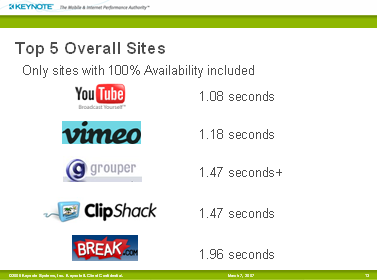Bigger isn't better with Web streaming performance

Small user generated Web video companies such as Vimeo and Grouper can offer better performance than big players.
That's one of the takeaways from a study by Web monitoring service Keynote. The presentation will be given Thursday morning at a StreamingMedia.com Webinar.
Jeff Geiser, global director of streaming media and VOIP at Keynote, briefed ZDNet on his talk.
Geiser says that Keynote's main goal was to measure the performance of user generated Flash video players. In January, Keynote looked at 18 players including YouTube, Google Video, Guba, Metacafe, Vimeo and Revver. To be sure large players such as Google, YouTube and Yahoo have strong showings--YouTube has 100 percent availability and delivers video in 1.08 seconds and Yahoo video has the best connect time--but Keynote's findings are littered with strong performances from lesser known video services.

After measuring more than 250,000 streams from various places around the globe Keynote cooked up score dubbed Stream Q--a combination of connect time and buffer time. The project measured the user experience from the time you hit play.
Why is performance so important on these video sites? No one has figured out how to make money. So the game is to grab audience. If performance stinks revenue will be hard to come by.
"This segment of the industry has a revenue model that's not mature. The current game is to gain as many end user eyeballs as possible. The ability to serve that content is important to sustain revenue model," says Geiser.
Among the key results:
- 11 of 18 sites had 100 percent availability;
- One company used Akamai and one deployed rival Limelight. "Since there isn't a mature revenue model you may not see a lot of investment on infrastructure," says Geiser.
- Average availability was 97.49 percent. Worse availability was 43.4 percent.
- Average global Stream Q score was 4.09 seconds. In U.S. average score was 3.92 seconds.
- Metacafe was most consistent site. Dailymotion followed.
- Yahoo Video had best buffer time at 1.04 seconds. YouTube was third with 1.05 seconds. Vimeo third at 1.34 seconds.
- Yahoo Video had best Stream Q score at 1.08 seconds. YouTube had 1.18 seconds and Google Video had 1.47 seconds. Why the YouTube-Google Video disparity? Geiser surmises that YouTube's infrastructure hasn't been combined with Google Video's.
- And the worst video site takes a full 10 seconds to deliver video in a flash player.